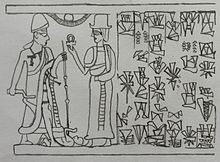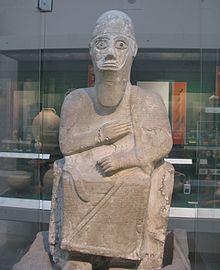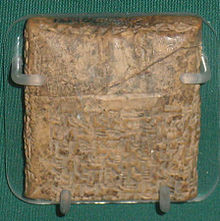Yamhad dynasty
| Yamhad Dynasty | |
|---|---|
| Country | King of Yamhad |
| Final ruler | Itur-Addu, King of Mukish (Alalakh) |
| Titles | Great King of Yamhad King of Alalakh (Mukish) Queen consort of Mari |
| Estate(s) | Syria, Turkey |
| Dissolution | 1344 BC |

The Yamhad dynasty
The dynasty was ousted during a short
History
In all likelihoods Yamhad was a tribal name.
Hammurabi I (re. c. 1764 BC) son of Yarim-Lim I ruled a prosperous Kingdom, The dynasty hegemony remained unchallenged and he was able to add Carchemish to his vassals,[9] his successor Abba-El I installed his younger brother Yarim-Lim on the throne of Alalakh in c. 1735 BC, thus creating a cadet branch of the dynasty under the hegemony of the great king in Aleppo.[10]
In Aleppo

The line of great kings in aleppo continued to hold hegemony over other Syrian kingdoms,
After the assassination of Mursili, Sarra-El a prince and a possible son of Yarim-Lim III regained aleppo and ruled a much smaller kingdom that again included Alalakh.[17][18] He was succeeded by his son Abba-El II,[19] then his grandson Ilim-Ilimma I who was the last member of the dynasty to rule Aleppo as its king,[20] he was killed in c. 1524 BC which put an end to the kingdom of Yamhad.[21]
In Alalakh

Two cadet branches ruled Alalakh, the first was founded by Yarim-Lim son of Hammurabi I in c. 1735,
The second branch was established by
Members
Bold text : Great king.
Kings in Aleppo
|
Kings in Alalakh
Other members
|
Family tree
King of Aleppo - King of Alalakh - Queen - Prince - Princess - Dotted line : relation uncertain.





| Sumu-Epuh re. 1810-1780 BC | Sumunna-Abi | ||||||||||||||||||||||||||||||||||||||||||||||||||||
| Yarim-Lim I re. 1780-1764 BC | Gashera | ||||||||||||||||||||||||||||||||||||||||||||||||||||
| Hammurabi I re. 1764-1750 BC | Shibtu | Zimri-Lim | |||||||||||||||||||||||||||||||||||||||||||||||||||
| Tatteya | Nakkusse | Yarim-Lim of Alalakh re. 1735-? BC | Abba-El I re. 1750-1720 BC | ||||||||||||||||||||||||||||||||||||||||||||||||||
Ammitakum | Yarim-Lim II re. 1720-1700 BC | ||||||||||||||||||||||||||||||||||||||||||||||||||||
| Hammurabi | Niqmi-Epuh re. 1700-1675 BC | ||||||||||||||||||||||||||||||||||||||||||||||||||||
| Abba-El | Irkabtum re. 1675- Middle 17th century BC | Hammurabi II re. Middle 17th century BC | Yarim-Lim III re. Middle 17th century BC -1625 BC | ||||||||||||||||||||||||||||||||||||||||||||||||||
| Sarra-El re. Early 16th century BC | Hammurabi III re. 1625-1600 BC | ||||||||||||||||||||||||||||||||||||||||||||||||||||
| Abba-El II re. Middle 16th century BC | |||||||||||||||||||||||||||||||||||||||||||||||||||||
| Ilim-Ilimma I re. Middle 16th century BC - 1524 BC | |||||||||||||||||||||||||||||||||||||||||||||||||||||
| Idrimi re. 1517-1480 BC | |||||||||||||||||||||||||||||||||||||||||||||||||||||
| Niqmepa | Addu-nirari | ||||||||||||||||||||||||||||||||||||||||||||||||||||
| Ilim-Ilimma II | |||||||||||||||||||||||||||||||||||||||||||||||||||||
| Itur-Addu | |||||||||||||||||||||||||||||||||||||||||||||||||||||
See also
- List of rulers of Aleppo
- Amorites
References
Citations
- ^ Facoltà di teologia Pontificia università della Santa Croce (Vaticano Città del). Diss Ertationes. p. 160.
- ^ ISBN 9780931464072.
- ISBN 9780802058737.
- ISBN 9781134159086.
- ISBN 9781134520626.
- ^ Jack M. Sasson (1969). The Military Establishments at Mari. p. 2+3.
- ISBN 9780810939455.
- ISBN 9004117326.
- ^ ISBN 9781134520626.
- ISBN 9780191591044.
- ISBN 9781575060668.
- ^ Akadémiai Kiadó (1984). Acta Antiqua Academiae Scientiarum Hungaricae. p. 7+27.
- ISBN 9780521082303.
- ^ ISBN 9780520203075.
- ISBN 9780199240104.
- ISBN 9780191002922.
- ISBN 9780199240104.
- ^ a b Michael C. Astour. Orientalia: Vol. 38. p. 382.
- ISBN 9781134159079.
- ISBN 9789186098865.
- ^ Michael C. Astour. Hittite History and Absolute Chronology of the Bronze Age. p. 92.
- ^ a b wilfred van soldt (1999). Akkadica, Volumes 111-120. p. 109.
- ISBN 9789630507608.
- ISBN 9781134259588.
- ISBN 9780931464416.
- ISBN 9780520203075.
- ISBN 9781934309148.
- ISBN 9780199240104.
- ISBN 9780931464157.
- ISBN 9781934309148.
- ISBN 9781134159086.
- ISBN 9780199557301.
- ISBN 9780521828857.
- ^ wilfred van soldt (1999). Akkadica, Volumes 111-120. p. 108.
- ISBN 9781575061139.
- ISBN 9789186098865.
